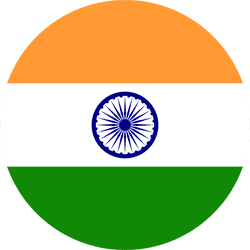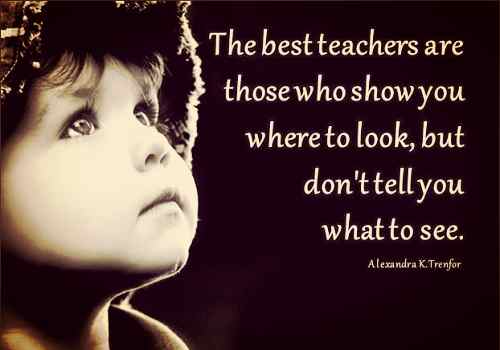Categories(658 Blogs)
Select Category
Watch Right Now
Teacher App - Class
Schedule & Attendance Management App
Parent App from Edsys

Best School Bus Tracking System

Cashless School - For Smart Schools of Tomorrow
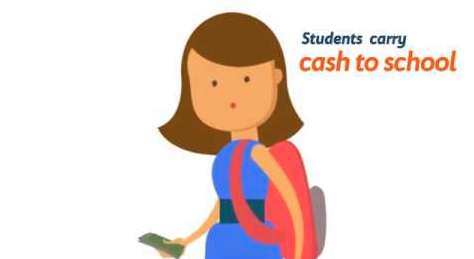

Solar System for Kids: Planets in Solar System, Facts about Solar System
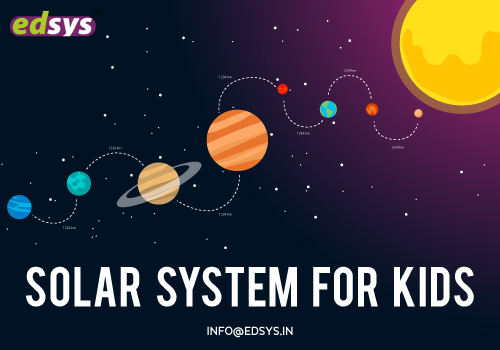
Have you ever wondered why there is so much popularity for the ‘solar system for kids’ projects? Unlike other topics, kids would love to know more about its formation and other interesting facts that connect them to nature.
Table of Content
- Planets of Solar System
- How to Draw the Solar System for Kids?
- Solar System images for kids (Free solar system printables)
- Facts about Solar System for Kids
- Solar System Model for Kids
The solar system or a planetary system was formed about 4.7 billion years ago. The system is mainly composed of the sun and the eight planets that travel around it.
Even when it appears as empty space from a distant view, close observation can find countless asteroids, comets, and a lot of small icy objects.
Interestingly, this solar system is just a small portion of a huge arena of stars, the Milky Way galaxy and it orbits around the galaxy just once in 225 million years. And this galaxy is just one among the many billions of galaxies that form the Universe.
Get FREE Games Apps (Check it Now)
Planets of Solar System
No kid needs an introduction for the sun, as this home star is an integral part of our daily life. However, they will be surprised to know that it is just one among 200 billion other stars in the Milky Way.
Now let us have a look at the eight solar system planets that orbit around the sun.
(1) Mercury

This is the closest planet to the sun which is also the fastest among the planets. It can travel through space with 31 miles per second/ 50km per second.
The width is just as same as the Atlantic Ocean. Interestingly, about 18 Mercury planets can fit into the Earth.
(2) Venus

Next in the line is Venus which is also popular as evening or morning star.
Interestingly, its composition causes light to reflect off the surface. That is another reason why it is the brightest during the night sky just after the moon.
It comprises craters, volcanoes, and mountain ranges and is the hottest among the planets.
(3) Earth

Then we have the fifth largest planet of all which features Moon, a large natural satellite. This is the only planet where the presence of life is found as of now. Interestingly, about 70% of Earth is composed of water.
(4) Mars
This is the second smallest planet of the solar system which scientists believe to be a future human habitat. However, huge dust storm covers the planet and is very dry and cold. It features a Volcano called Olympus Mons and Mount Everest is almost three times smaller to it.
(5) Jupiter

This is the largest planet of the solar system. It features a ‘Great Red Spot’ which is an indication of a storm that is blowing for 350 years or more. The largest moons of the whole system are also found in Jupiter which includes Europa.
(6) Saturn

It is also a gas giant that lies on a small rocky surface. It is famous for its rings which is very clear, unlike other gas giants. Titan is the moon of the planet which is the second biggest in the solar system.
(7) Uranus

It is the second furthest when it comes to distance from the sun. This also means that it has to travel almost 84 years to orbit once around.
It is bluish in color due to the presence of gas. Interestingly, it takes 21 years for winter and summer at the south and north poles.
Get FREE Games Apps (Check it Now)
(8) Neptune

It also composes of same gases in the atmosphere like that of Uranus. This makes it deep blue in color. It is the farthest planet from the sun and takes almost 165 years to go once around it.
How to Draw the Solar System for Kids? (Solar System Drawing for Kids)
Drawing a solar system for kids is a lot easy than it actually looks if you follow a simple step by step procedure. Let us see.
- First of all, draw the Sun on the leftmost side of the page. See that you draw a larger circle to represent its large size but leave enough space on the right side to draw the planets. You may simply draw it freehand or use a compass to form a perfect circle. Shade it with red, yellow, or orange to indicate its hot gases.
- Draw a small circle to the right of the sun to denote Mercury. Make sure that it is the smallest among the circles you are about to draw as it is the smallest planet in the solar system. Shade it with dark grey as an implication of its solid outer crust.
- Now draw a larger circle than what you drew for Mercury to represent Venus. Shade it with brown and yellow colors to denote its surface with clouds of sulphur dioxide.
- Fourth in the list is Earth which is more or less similar in size of Venus but only slightly bigger. So draw a slightly larger circle than Venus. Shade it with blue for oceans, green for continents, and some white space to indicate the atmosphere.
- Now it is the turn to draw the second smallest planet of the solar system. So draw a circle for Mars which is smaller than Earth and Venus but slightly larger than Mercury. Then shade it with red and brown colors to denote the iron oxide that covers its surface.
- Now draw Jupiter to the right of Mars which is the largest among the planets and so draw the largest circle. But see that it is smaller than the circle for Sun as it is almost 10 times bigger. Shade it with red, orange, yellow, and brown to show the diverse chemicals in its atmosphere.
- Draw another circle right to Jupiter to represent the second largest planet, Saturn. So the circle should be smaller than Jupiter but bigger than other planets. Also draw some rings for the circle and shade everything with yellow, gray, brown, and orange.
- Now draw a circle to the right of Saturn which should be the third largest circle among the planets, for Uranus. Shade it with light blue color to represent its composition of ice.
- Then draw the final circle right to Uranus to represent Neptune which is the fourth largest among the planets. So the circle should be smaller than Jupiter, Saturn, and Uranus but bigger than other planets. Its atmosphere contains methane which can be represented in a dark blue color.
- The final step of solar system drawing is to sketch the orbital path for each planet to represent the fact that all of the orbits around the sun. Make sure that a curved path should be drawn from the top and bottom of all circles that represent planets. As each planet travels around the sun, these paths need to be extended off the edge of the page and towards the Sun. Special care should be needed to see that orbital paths are not intersecting with each other.
Also Read:
- General Knowledge For Kids(230 + Simple GK Questions and Answers)
- 50 Math Riddles for Kids with Answers
- Multiplication Charts 1 -12 & 1-100 [Free Download and Printable]
Solar System Images for Kids (Free Solar System Printables)
Our solar system is always a world of fantasy for kids and they can easily connect with them through fun. Teachers always use some creative solar system pictures to teach them about its composition without giving the actual feel of learning.
-
Image 1
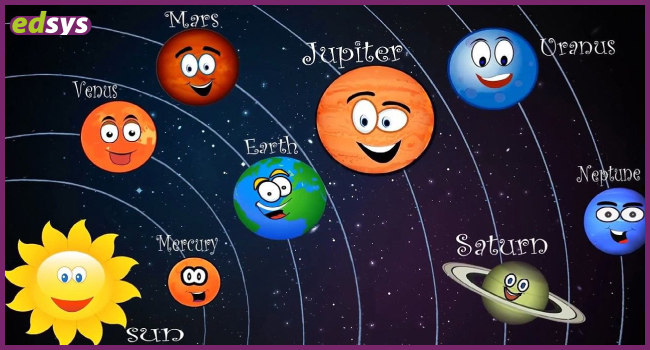
Download For Free
-
Image 2
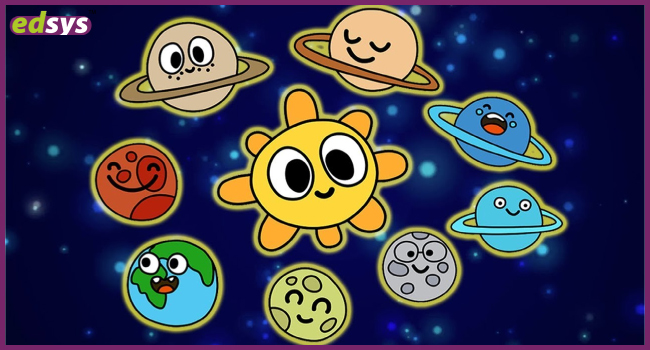
Download For Free
-
Image 3
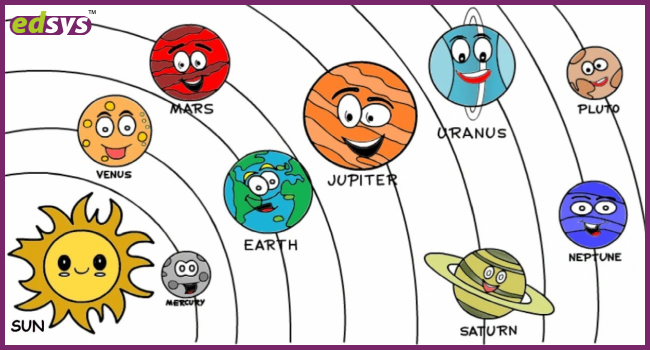
Download For Free
Facts about Solar System For Kids
There are lots of interesting facts that are connected with the solar system. Some of them are really informative and helps to connect with other subject areas while there are some fun facts too. Let us have a look at some key solar system facts.
- The existence of the Solar System was unaware for many thousands of years and humans supposed that Earth lies at the centre of the Universe.
- Neptune was the latest planet to be discovered
- The asteroid belt that can be located between the orbits features a huge number of unevenly shaped asteroids.
- There are 4 inner planets and 4 outer planets in our solar system.
- The terrestrial planets or inner planets are smaller which are composed of rock and metal.
- All of our planets are on the same “plane” and orbit in the same direction.
- The gas giants or outer planets are much larger and are composed of hydrogen, helium and other gases
- The Sun comprises 99.86 percent of the Solar System’s identified mass followed by Jupiter and Saturn.
- With the latest available information, Earth is the only planet which is known to have oceans
- Saturn’s ring comprises completely of water ice particles.
- The heaviest and biggest planet in our solar system is Jupiter.
- The lightest and smallest planet in our solar system is Mercury.
- Venus is the brightest planet in our sky and is the closest to the Earth.
- Venus is almost the same size as that of Earth but it is 10 times hotter.
- Moons orbit around the planets and not the sun and almost all planets have moons.
Solar System Model for Kids
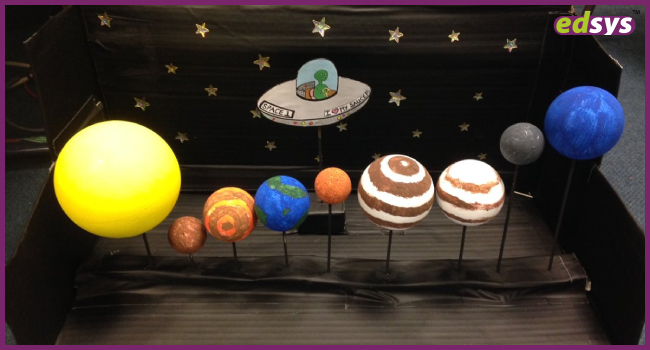
Parents and teachers can make a simple solar system model for kids at home or classroom with just a few items and some patience. A visual representation of the system will give kids a deeper understanding when studying about space. Involve kids also during this project so that they can easily compare the size of planets and see the way it rotates around sun.
Let us have a look at the items needed and the stepwise Procedure:
- Take a 10-inch Styrofoam ball which can be used to represent the solar system base and 8 small Styrofoam balls of different sizes (5, 4, 3, 2 ½, 2, and 2 each of 1 ½ and 1 ¼ inch) to represent the planets.
- In order to suspend the planets, take wooden dowels, coat hangers, or skewers. And take pipe cleaners, color paper, and Styrofoam sheet to set up rings for Saturn.
- Keep the 10-inch ball aside and stick the skewer or similar stuff about half of all other balls.
- Select balls of different sizes in the order (5, 1 ¼,1 ½, 1 ½, 4, 3, 2 ½, 2, 1 ¼, 4, 3, 2, 2 ½) to represent Sun, Mercury, Venus, Earth, Mars, Jupiter, Saturn, Uranus, and Neptune.
- Paint these balls with different colors to represent the planet’s surface. You can refer for color suggestions from the section “How to Draw Solar System for Kids?”
- Set up Saturn’s famous rings using the color paper, extra Styrofoam, and pipe cleaners.
- Now set up the stand for the model. Cut the 10-inch ball that was kept aside into half to form the base. The dome should be set up with a flat bottom. Stick these balls into the base in the order they appear in the solar system.
Solar System For Kids – Final Thoughts
There is no wonder why the solar system for kids projects is so popular. It is one of the most interesting areas of study and kids have a lot to explore about space every time they approach the subject. Hope teachers and parents will use these interesting facts, models, and drawings of the solar systems to make the study time fun and informative.
Recent Blogs
Our Educational Services
Popular Blogs
Subscribe

SUBSCRIBE TO OUR NEWSLETTER
Sign Up and Recieve the Latest News
Don’t Worry, We Don’t SpamExplore Our Extensive Researched Educational App Directory
Visit Now